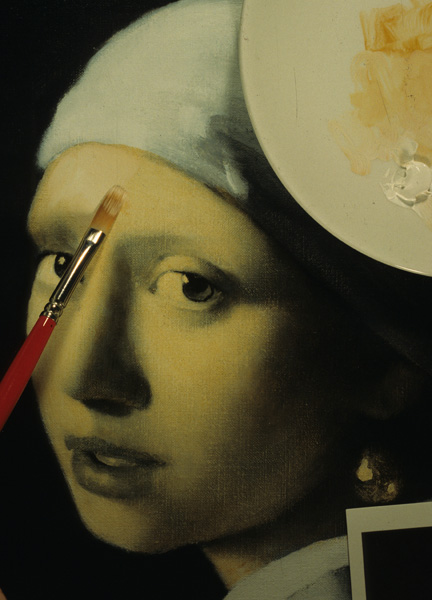
PAGE 3: Painting a Copy of Jan Vermeer's "Girl with a Pearl Earring"
Using Oil Glazing Technique and a Grisaille (Monochromatic Gray) Underpainting

For the very first overall glaze application, I am using a simple mixture of cadmium red medium and yellow ochre mixed with some of the glazing medium that I have prepared. The more medium you use, the more it dilutes the paint, and reduces the color intensity, just as in watercolor painting when you thin the paint with water. The oil painting medium recipe I am using is composed of equal parts by weight of linseed oil, pure gum turpentine, and damar varnish (5 lb. cut). I am mixing the paint on a small porcelain plate because it provides a nice white background that makes it easier for the colors of paint I am mixing to show up in these photos.

Once the entire face has been coated with a uniform glaze layer, a soft brush is used to work thinly applied white paint into the wet glaze to bring back the highlighted areas. The idea is to apply a glaze, then bring the highlights back out by scumbling white paint into the glaze in those areas, while letting the glaze build color and richness in the shadow and middle value areas. The damar varnish in the glazing medium tends to allow each coat to dry fairly quickly, allowing a subsequent glaze layer to be applied, often within 24 hours. This drying process can be sped up even more through the addition of a few drops of cobalt drier to your painting medium. Vermeer's technique, and glazing technique in general, does not tend to allow for the completion of a painting in a single day.

At this stage, a single glaze layer has been applied and white paint has been scumbled into it to bring the highlighted areas back out. These lighter area are primarily to the left side, on the cheek, forehead, and the edge of the nose. The resulting color is now similar to the effect achieved in a hand-tinted black and white photograph, where the underlying gray still shows through clearly, and the color effect is weak, and lacking in richness. Only by building up numerous layers of glazes is a rich color effect achieved in the shadows and middle values. A common mistake made by students experimenting with glazing is to not take the effect far enough, and the painting never gets beyond being similar to the weakly colored effect of a tinted black and white photo. Executing a successful glazed painting requires more than just applying a coat or two of uniformly colored tinting -- you do still have to actually paint in order to create a successful painting.